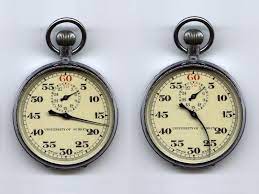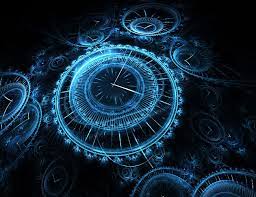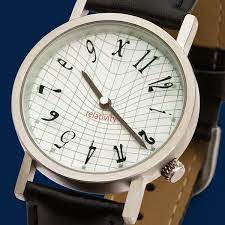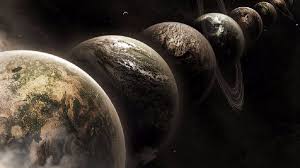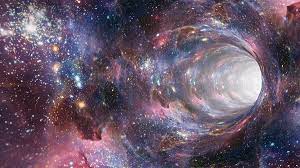THE NATURE OF TIME IN QUANTUM GRAVITY
- planck
- Aug 18
- 10 min read
On December 14, 1922, Albert Einstein gave a lecture at Kyoto University in which he stated: "The key that led me to formulate the theory of relativity was a profound analysis of the concept of time." More than 100 years later, modern physics still hasn't found a satisfactory explanation for what is probably one of the greatest problems in physics: the fundamental nature of time.
Before the 20th century, our intuitive image of classical time flowing continuously and homogeneously for all observers was perfectly captured by the equations of Newtonian mechanics. At the beginning of the 20th century, two enormous revolutions in physics took place that would change our way of seeing the world forever. The first of these, general relativity, completely destroyed this intuitive and "peaceful" Newtonian image of time. The second, quantum mechanics, radically changed our classical way of understanding the world; however, somewhat paradoxically, it did not substantially alter the classical image of time: it remained an external, continuous, and absolute parameter. For many physicists, this is unacceptable: we must apply the second great revolution also to the concept of time . It is very likely that until we find a way to achieve this, we will not have a complete picture of the Universe we inhabit and of our most fundamental physical theories.
In this article, we'll delve into the fundamental nature of time. To do so, we'll attempt to visualize it in a completely different way than we're used to, and we'll discover a radically different view of our Universe: a Universe with time that runs according to the counterintuitive laws of the quantum world. Future studies and experimental projects will tell us if this is our real Universe.
Reflections on time in general relativity
Imagine two clocks on the surface of the Earth. I throw one up and leave the other motionless on the ground. When the first clock falls, I compare their readings and am horrified to find they don't match. Which reading is correct? Which clock tells the true time? Clearly, these questions are pointless. This example makes it clear that the first thing we must do is try to erase the classical, obsolete image of time from our minds. To this end, we will briefly review the main conclusions about the nature of time in general relativity:
1st) There is no absolute time , there is no reference system with a privileged clock, time for each observer flows at a different rate.
2nd) To make measurements in general relativity we need to couple two clocks, an isolated measurement of time makes no sense, only the difference between two clocks makes sense.
3rd) The differences between two clocks depend on the path followed in four-dimensional space-time, specifically, on the differences in the metric associated with each path.
4th) The metric of each path changes dynamically depending on the mass-energy, that is, space-time (gravity) and matter constantly interact dynamically.
With these four (counterintuitive but classic) reflections on time, we will attempt to make the other great conceptual leap: the transition from classical time to quantum time.
Differences in the time of Quantum Mechanics and General Relativity
As we briefly saw in the previous section, in general relativity, time is dynamic and not absolute; that is, it depends on the geometry of space-time, which in turn depends on matter fields. In fact, relativity predicts a dynamic interaction between geometry (gravity) and matter fields.
However, in the mathematical formalism of quantum mechanics, time is absolute and not dynamic, that is, it is a simple external parameter that does not depend on other variables (this can be clearly seen in the Schrodinger equation). In fact, time is not even an operator like the rest of the observable magnitudes in quantum mechanics.
These contradictions between our two main fundamental theories constitute the so-called problem of time. How can we try to reconcile two such different visions? Although we do not yet have a quantum theory of gravity, we can attempt to perform a first quantization of the equations of general relativity and analyze the form that this "quantized" time takes.
Quantum mechanics as a sum of Feynmann histories
Before describing the quantization of general relativity, we will briefly describe the formulation of quantum mechanics discovered by Feynman. This formulation is completely equivalent to the standard formulation of Schrodinger and Heisenberg.
Consider a particle initially at position x1 at time t1. What is the probability that this particle is at point xn at time tn?
Feynman discovered that this probability is equivalent to summing the contribution of all possible paths between x1 and xn:

To find the probability that a particle at point x1 at time t1 is at point xn at time tn, the probabilities of all intermediate positions (x2,x3,...xn) must be evaluated, which is equivalent to taking into account all possible trajectories between x1 and xn.
Specifically the probability is:

Where D[x(t)] is a functional that implies a sum of all possible paths (functions) that starting at point x1 reach point xn. The Lclassical integral is the action (S) and is basically the difference between the kinetic energy and the potential energy of the particle. The paths in which the variation of the action is zero or very small (principle of least action) are the most probable while the paths with great variation of S are highly improbable, therefore, at macroscopic distances we observe the classical trajectory which is the most probable (basically the one that consumes less time).

Each possible trajectory between points x1 and x2 has an associated action S. At macroscopic distances, the trajectory with the lowest action prevails in the sum, since it is the most probable. This is why we do not see superpositions at macroscopic distances and only detect a classical world.
The conclusion of Feynman's work is another severe blow to our intuitive view of the world: in the quantum world, the trajectory of a particle is not a specific trajectory between two points in space-time, but rather a weighted sum of all possible trajectories.
The strange equation of quantum gravity
In 1926, Erwin Schrödinger published a paper in which he was able to describe the complete dynamics of a hydrogen atom based solely on the Schrödinger equation for the electron coupled to the electric potential. Schrödinger started from the Hamiltonian of an electron within an electric potential:

He then converted the square of the variation of the action (multiplied by hi) into a quantum wave function PSI(x,t) that contains all the information about the dynamics of the system:

In 1965, physicists John Wheeler and Bryce DeWitt decided to apply the same successful strategy to Einstein's equations of gravity. To do so, they started from the equations of general relativity in their Hamiltonian-Jacobian formulation:

(qabc are the components of the three-dimensional metric, R[q] is the Ricci scalar and S[q] is the Hamilton-Jacobi functional) and analogously to Schrödinger's work they transformed the square of the functional into a quantum wave function that contains all the information about all possible geometries that satisfy Einstein's equations:

This equation is called the Wheeler-DeWitt equation , and the wave function PSI[q] can be considered a kind of wave function of the Universe. As we shall see, this expression has extraordinary qualities, although it is tremendously complicated to apply and interpret. One of the fundamental virtues of this equation is that it constitutes the first fundamental expression for quantum gravity, and it also does not depend on a predetermined space-time. Therefore, this equation does not describe what happens in space-time but what happens to space-time itself.
A timeless Universe composed of a superposition of geometries
The first property, the one that seems the most "exotic" of the Wheeler-DeWit (WdW) equation, is that it does not depend on time, but only on the three-dimensional metric. The time variable has disappeared! At first glance, this seems very strange, however, this is due to the peculiar way in which general relativity treats the time variable: time is not defined at an instant but along a "world line" of the object we want to measure. The time variable t in general relativity has no physical meaning; the measurable magnitude of time is the so-called proper time:

Therefore, time does not depend on an external parameter t but on a sum (an integral) along a path which is a function depending on q and dq/dt and the information about these two variables is available in the Jacobian expression of the WdW equation.
The second "strange" property is the interpretation of the wave function PSI[q]. This can be understood as the wave function of the gravitational field of the Universe, that is, a kind of wave function of the Universe. As we saw earlier, this wave function arises from the functional S[q] in the Hamiltonian-Jacobian formulation of general relativity. A functional is a sum of all functions that satisfy the imposed requirement; therefore, the wave function psi[q] encompasses all permitted three-dimensional geometries. by general relativity .
If we want to visualize something resembling quantum time, we should imagine a "superposition" or "fluctuation" at the fundamental level between possible "worldlines" (between possible Universes in the WdW equation). From what we have seen, we can make the following speculation: the global wave function of the Universe contains many possible geometries, such that space and time "fluctuate" between different geometries. The probability of observing one geometry or another (measurement) is given by the weighted sum of all possible paths. The measurement would be equivalent to coupling two clocks to a specific worldline (Universe).

Image taken from: The theory of relativity
This view of the Universe would be linked to the so-called many-worlds interpretation of quantum mechanics by Hugh Everett . In fact, the image we obtain from the Wheeler-DeWitt equation is not compatible with the Copenhagen interpretation of quantum mechanics since it requires the existence of a classical world in which the result of the measurement materializes. In this interpretation, the wave function is real, it does not "collapse", and all possible values really exist. In this way, it is not necessary to invoke a "dark", inexplicable, irreversible and non-unitary process that produces the collapse of the wave function (1), and the fundamental equations maintain the linear character of Schrodinger's wave equation. An important fact to note is that the original work of Hugh Everett III
He doesn't mention the words "many worlds" or "many universes" at all; in fact, his original work is called "Theory of Universal Wave Function." Everett simply explains that for each possible outcome of a measurement, there exists exactly one observer who "records" the result of that measurement. This has led many physicists to postulate the existence of many worlds, one for each possible outcome; however, as Everett himself explained, this interpretation is flawed and is due to our need to interpret the world classically.
The Hartle-Hawking State of the Universe
In practice, the Wheeler-DeWitt equation is very difficult to solve and can only be solved approximately by considering finite degrees of freedom and establishing certain boundary conditions. One of the best-known and most influential solutions to the Wheeler-DeWitt equation is the so-called Hartle-Hawking no-boundary proposal.
This proposal arises by applying two fundamental conditions:
1st) Given a sum (path integral) of possible geometries, only those that produce a Universe like the one we currently observe will be allowed, which implies that the sum will only be performed on continuous geometries that do not have singularities.
2) The initial conditions correspond to a Euclidean space-time. This space-time arises by allowing the time coordinate to take on complex values (the famous complex time popularized by Hawking). This causes the time coordinate of the Lorenzian metric to change from negative to positive (when multiplied by -1), which means that time actually behaves like a spatial coordinate (coordinates with a positive sign):

In the Hartle-Hawking boundaryless proposal, the Universe emerges from a space-time with four spatial dimensions, since the fourth dimension (time) behaves like another spatial coordinate. Thus, the Universe has no "edges" or singularities; there has been no initial time, and therefore, asking what existed before has the same meaning as asking what lies south of the Earth's South Pole.
Image taken from: Hawking's last article in Naukas
By applying these two conditions, Hartle and Hawking discovered something astonishing: the most likely Universe is one that begins with a brief period of cosmic inflation, after which a large period of accelerated expansion ensues. Just after inflation (the Big Bang), the fourth spatial dimension "opens up" and begins to behave like a time dimension . This model presents a feasible hypothesis for the possible quantum creation and evolution of our Universe! Before this proposal, many physicists believed that something like this was beyond the reach of science.

Image taken from: Hawking's last article in Naukas
Furthermore, this proposal gives us several very valuable clues about the possible nature of time:
- Time arises from a Euclidean region with imaginary time. In this region (on a quantum scale), the usual notions of space and time cease to have their usual meaning. In fact, this region can be considered a kind of "bubble of nothingness" where quantum fields, space, and time do not exist.
- At small scales there is quantum interference between different "space-times" (similar to how in the Feynmann path integral a particle takes all possible paths) but when the scales are large the interference between space-times is "destructive" and a classical space-time prevails (similar to how in the Feynmann path integral the classical trajectory prevails when the distances are large).
- So-called quantum cosmology studies our entire Universe from a universal wave function. In this way, each possible value of the wave function (eigenvalues) represents a possible Universe, and probabilities can be assigned to each possible Universe.
Conclusions
We still don't have an answer to the fundamental nature of time. The WdW equation is very difficult to interpret and suffers from several technical problems that make it very difficult to apply in practice. However, our mathematical formulations of quantum gravity, although still incomplete, clearly point to a kind of "sum of geometries," "sum of histories," or "sum of Universes," and the notion of quantum time must include interference between different space-times at a fundamental level. This new view of the Universe represents a huge conceptual leap comparable to that of general relativity or quantum mechanics and allows us to solve the great problem of initial time: there was no initial singularity; our Universe-Multiverse has existed "since forever," and time emerged from a Euclidean space-time through a period of inflation, giving rise to the Universe we observe today.
Grades:
(1) Although the concept of wave function collapse can be considered obsolete when replaced by the decoherence process, the latter still does not solve the measurement problem since there is still a superposition of states between the measured system and the measuring apparatus.


